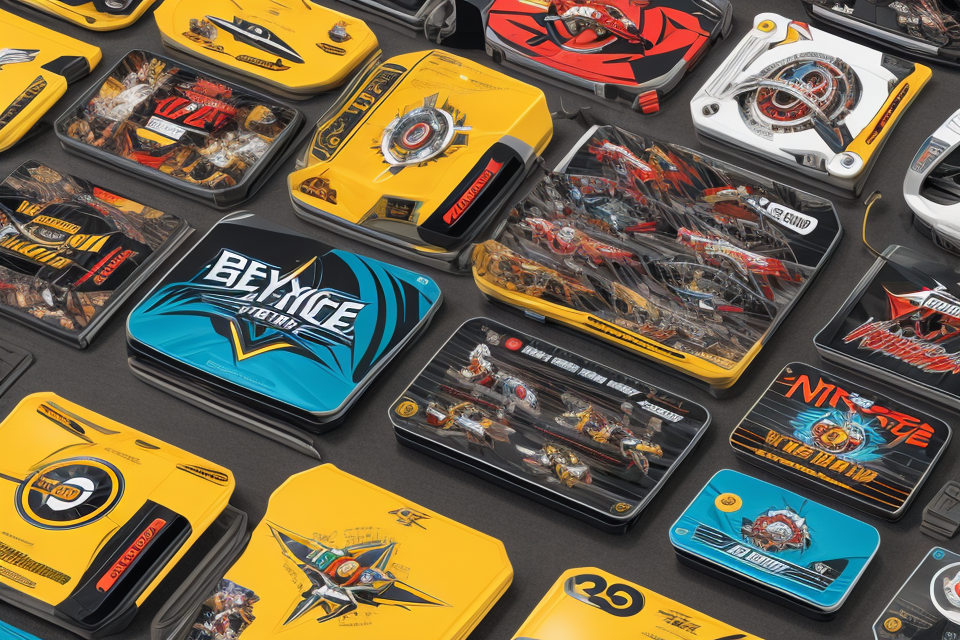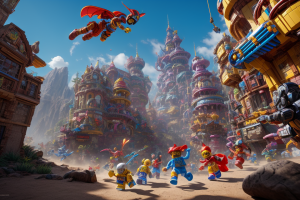
Beyblades, the popular spinning tops that have taken the world by storm, have a fascinating history that dates back to ancient times. Did you know that these incredible toys were originally called something else entirely? Join us as we explore the captivating story of Beyblades and uncover the truth about their original name. From the ancient civilizations that first created them to the modern-day competitions that draw crowds, this is a journey you won’t want to miss. So, get ready to discover the amazing history of Beyblades and find out what they were originally called.
Beyblades are a type of toy that were originally called “Beyblade: Vforce” when they were first released in Japan in 1999. The toys were created by the company Takara Tomy and became very popular among children and collectors alike. The toys consist of a spinning top called a “beystadium” and a “beyblade” that is placed on top of it. The goal of the game is to knock your opponent’s beyblade out of the stadium, while trying to protect your own. The popularity of Beyblades spread to other countries and the franchise has since become a global phenomenon.
Beyblade’s Origin
Beyblade’s Creation
Beyblades were originally called “Beyblade: The Game of Kings” when they were first released in Japan in 1999. The game was created by the Japanese toy company, Hasbro, and was inspired by the ancient Japanese art of Kendo, which is a martial art that involves the use of bamboo swords.
The concept of Beyblades was to create a competitive game that would incorporate elements of physical and mental strategy, while also providing a fun and exciting experience for players. The creators of Beyblades aimed to create a game that would appeal to a wide range of players, from children to adults, and would be easy to learn but difficult to master.
The original Beyblades were made of a combination of plastic and metal, and each one was designed to represent a different type of animal or creature. The Beyblades were designed to be customizable, allowing players to change the weight and balance of their Beyblade to suit their playstyle.
In addition to the Beyblades themselves, the game also included a launcher, which was used to launch the Beyblade into the arena. The arena was a circular ring with a raised center, and the goal of the game was to knock your opponent’s Beyblade out of the ring while defending your own.
Overall, the creation of Beyblades was a unique blend of ancient Japanese martial arts and modern toy design, resulting in a game that has become a beloved part of many people’s childhoods and continues to be popular today.
Beyblade’s Popularity
- The Beyblade franchise originated in Japan in the late 1990s and quickly gained popularity worldwide.
- The toys, which consisted of spinning tops with various designs and attributes, became a cultural phenomenon, with children and adults alike collecting and battling them.
- The franchise expanded to include anime, manga, and video games, further fueling its popularity.
- In the early 2000s, the Beyblade craze reached its peak, with toy stores struggling to keep up with demand and schools banning the toys due to their popularity distracting from studies.
- The popularity of Beyblades transcended borders and became a global phenomenon, with variations of the toy being sold in different countries under different names.
- Despite the passage of time, the Beyblade franchise remains popular to this day, with new generations of fans discovering and enjoying the toys and media.
Beyblade’s Name Change
Reason for the Name Change
Origins of Beyblade
The concept of Beyblades can be traced back to ancient times, where they were originally called “Shogi” in Japan. Shogi is a traditional Japanese board game that involves strategic movements of pieces on a grid-like board. It is said that the game was introduced to Japan in the 8th century, and over time, it evolved into a more complex and competitive game.
Evolution of Beyblade
Over the centuries, Shogi continued to evolve and adapt to the changing times. In the late 19th century, a new version of Shogi was created, which involved the use of small metal balls called “mancala” that were placed on the board. This new version of Shogi was called “Shogi-Mancala” and gained popularity in Japan.
Beyblade’s Creation
In the 21st century, the concept of Beyblade was created as a modernized version of Shogi-Mancala. The creators of Beyblade aimed to create a game that would appeal to a wider audience, especially children. They incorporated elements of the traditional game of Shogi-Mancala while adding a new twist, which involved the use of spinning tops called “beys” that battled against each other on a customizable arena.
Marketing and Popularity
Beyblade was initially marketed as a toy and quickly gained popularity among children and collectors alike. The name “Beyblade” was chosen to represent the blend of two elements: “bey” which referred to the spinning tops, and “blade” which referred to the customizable arena where the tops battled. The name change was aimed at making the game more appealing to a wider audience and easier to market.
Impact on Pop Culture
Beyblade’s name change had a significant impact on pop culture. The game became a phenomenon, with children all over the world collecting and battling with their Beyblades. The popularity of Beyblade led to the creation of an anime series, which further increased the game’s popularity. The name change allowed Beyblade to become a cultural icon and a beloved game that continues to be enjoyed by children and adults alike.
New Name and Marketing Strategy
In 2002, the creators of Beyblade, TOMY Company Limited, decided to rename the product to capitalize on its popularity and expand its market reach. The original name of the toy, “Beyblade,” was derived from the word “Bey,” which means “warrior” in Arabic, and “blade.” However, as the product gained widespread popularity, the name needed to be adapted to better reflect its brand identity and appeal to a broader audience.
To achieve this, TOMY implemented a new marketing strategy that included renaming the product to “Bakugan” in Japan and “Beyblade” in other countries. The name change aimed to emphasize the toy’s unique selling points, including its dynamic and fast-paced gameplay, which was reminiscent of the Japanese word “bakugan,” meaning “explosive” or “sudden.”
Additionally, the marketing strategy involved introducing new product lines and merchandise, such as trading cards and animated television shows, to further enhance the brand’s identity and reach. This helped to create a comprehensive and immersive world around the Beyblade toy, which captivated children and fans alike.
The name change and new marketing strategy proved to be highly effective, as the rebranded product became even more popular, and its global sales increased significantly. This allowed Beyblade to maintain its position as a leading toy brand in the collectible and competitive battling category, cementing its status as a beloved childhood pastime for generations of fans around the world.
Beyblade’s Impact
Beyblade’s Influence on Toy Industry
When Beyblade first hit the market, it was a game-changer for the toy industry. It introduced a new concept of toys that were not only fun to play with but also encouraged physical activity and social interaction. Here are some ways in which Beyblade impacted the toy industry:
Revitalizing the Toy Industry
Beyblade revitalized the toy industry by introducing a new concept of toys that were more engaging and exciting for children. The spinning tops, which were the core of the game, were unlike any other toys on the market. The game required players to use skill and strategy to outsmart their opponents, which made it more appealing to children. The toy’s popularity also encouraged other toy manufacturers to create similar products, which led to a renewed interest in physical toys.
Encouraging Physical Activity
Beyblade encouraged physical activity by requiring players to spin the tops and launch them onto a circular arena. This required players to use their hand-eye coordination and physical strength to control the tops. The game also encouraged social interaction, as players could compete against each other in a fun and exciting way. This made Beyblade a popular choice among children who wanted to play and have fun while also getting some exercise.
Promoting Social Interaction
Beyblade also promoted social interaction by encouraging children to play together. The game required two players to compete against each other, which promoted friendly competition and social interaction. The game’s popularity also led to the creation of Beyblade clubs and tournaments, which allowed children to connect with other fans of the game. This social aspect of the game made it even more appealing to children, who enjoyed the sense of community and camaraderie that came with playing Beyblade.
Overall, Beyblade had a significant impact on the toy industry by introducing a new concept of toys that were both fun and engaging. The game’s popularity encouraged physical activity and social interaction among children, which made it a popular choice among parents and children alike.
Beyblade’s Fanbase and Community
Since its introduction in the late 1990s, Beyblade has amassed a large and dedicated fanbase worldwide. The franchise’s popularity has transcended borders, attracting fans from different cultures and age groups. The community is characterized by its passion for the game and its willingness to participate in various Beyblade-related activities.
The fanbase of Beyblade is predominantly composed of children and teenagers, who are drawn to the game’s exciting and competitive nature. However, the franchise has also attracted adult fans who appreciate the game’s strategic depth and the nostalgia it evokes. Many fans have been collecting Beyblade toys and participating in tournaments since they were children, forming a strong emotional connection with the franchise.
Beyblade’s fanbase is highly active, with numerous online communities and forums dedicated to the game. These platforms allow fans to share their collections, discuss strategies, and organize local tournaments. Additionally, the franchise has a strong presence on social media, with official accounts regularly posting updates and interacting with fans.
Beyblade’s fanbase is also characterized by its camaraderie and sense of community. Fans often collaborate on customizing their Beyblades and sharing their creations with others. The franchise’s popularity has also led to the development of organized competitive scenes, with regional and national tournaments attracting hundreds of players. These events provide a platform for fans to showcase their skills, make new friends, and connect with other enthusiasts.
Overall, Beyblade’s fanbase and community are vibrant and dedicated, reflecting the enduring appeal of the franchise. The game’s unique blend of strategy, skill, and entertainment has captivated fans for over two decades, and it continues to inspire new generations of players worldwide.
Beyblade’s Legacy
The Beyblade Phenomenon
The Beyblade Phenomenon
The Beyblade Phenomenon refers to the massive popularity and cultural impact of the Beyblade franchise, which originated in Japan and gained global recognition. This phenomenon transcended borders and captured the hearts of millions of fans around the world.
Key Factors of the Beyblade Phenomenon
Several factors contributed to the success and enduring appeal of Beyblade:
- Unique Concept: Beyblade combined elements of physical toys and competitive sports, making it a novel and exciting concept for fans of all ages.
- Engaging Storylines: The franchise’s narrative followed the journey of young characters as they faced challenges, developed friendships, and learned valuable lessons, resonating with audiences.
- High-Quality Animation: The anime series featured impressive animation and well-developed characters, making it appealing to both children and adults.
- Global Expansion: Beyblade’s global expansion ensured its reach in multiple languages and regions, further increasing its fan base.
Impact on Popular Culture
The Beyblade Phenomenon had a profound impact on popular culture, leaving a lasting impression on fans and influencing future media:
- Toy Line: The Beyblade toy line became a staple in many households, fueling the franchise’s popularity and inspiring countless battles and friendly rivalries.
- Anime Series: The anime series inspired numerous spin-offs, sequels, and adaptations, expanding the Beyblade universe and maintaining its relevance over the years.
- Merchandise: Beyblade merchandise, including clothing, accessories, and other collectibles, further solidified the franchise’s influence on popular culture.
- Influence on Other Media: Beyblade’s success inspired similar franchises, showcasing the power of its unique concept and engaging storytelling.
The Beyblade Phenomenon demonstrates the franchise’s remarkable ability to captivate audiences and leave a lasting impact on popular culture.
The Future of Beyblade
- The Beyblade phenomenon has transcended borders and has become a global sensation, with fans from all over the world
- The popularity of Beyblade has led to the creation of various spin-off series, including movies, animated series, and even stage shows
- Beyblade tournaments have become a staple in many countries, with professional players competing for large cash prizes
- The success of Beyblade has inspired many other toy companies to create similar products, but none have been able to replicate the same level of success
- Despite the passing of time, Beyblade remains a beloved franchise among fans of all ages, and its future looks bright with new releases and events constantly being announced.
FAQs
1. What were Beyblades originally called?
Beyblades were originally called “Beyblade” without the “Pro” prefix. The first Beyblade series was released in 1999 under the name “Beyblade: The Metal Fighting Game” in Japan, and it quickly gained popularity around the world. The name “Beyblade” comes from the word “Bey,” which is a fictional spiritual entity in the Beyblade universe, and “blade,” which refers to the spinning tops used in the game.
2. Why was the name changed to “Beyblade Pro” series?
The name was changed to “Beyblade Pro” series to reflect the evolution of the Beyblade game and the increasing competitiveness of the players. The “Pro” prefix signifies that the Beyblades in this series are designed for advanced players who are looking for a more challenging and competitive experience. The Pro series features higher quality components and more advanced designs than the original Beyblades.
3. Are Beyblade Pro series and regular Beyblades different?
Yes, the Beyblade Pro series is different from the regular Beyblades. The Pro series features a more advanced design and higher quality components that are designed to provide a more challenging and competitive experience for advanced players. The regular Beyblades are designed for casual play and are generally less expensive than the Pro series.
4. Which is better, Beyblade Pro series or regular Beyblades?
It depends on the player’s skill level and preferences. The Beyblade Pro series is designed for advanced players who are looking for a more challenging and competitive experience. The regular Beyblades are designed for casual play and are generally less expensive than the Pro series. If you are a beginner or casual player, the regular Beyblades may be a better option for you. However, if you are an advanced player looking for a more challenging experience, the Beyblade Pro series may be a better option for you.







